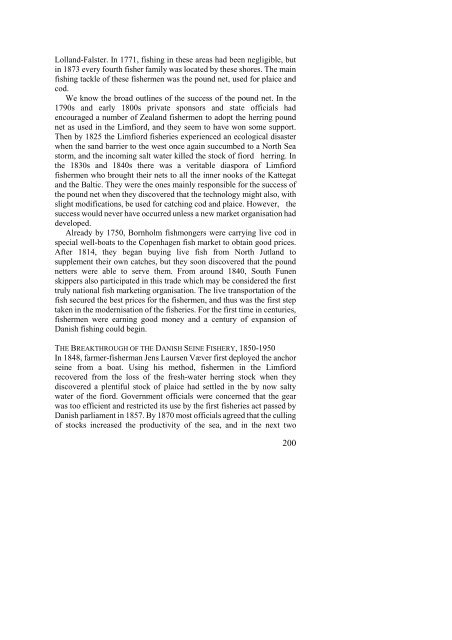The North Atlantic Fisheries, 1100-1976 - University of Hull
The North Atlantic Fisheries, 1100-1976 - University of Hull
The North Atlantic Fisheries, 1100-1976 - University of Hull
Create successful ePaper yourself
Turn your PDF publications into a flip-book with our unique Google optimized e-Paper software.
Lolland-Falster. In 1771, fishing in these areas had been negligible, but<br />
in 1873 every fourth fisher family was located by these shores. <strong>The</strong> main<br />
fishing tackle <strong>of</strong> these fishermen was the pound net, used for plaice and<br />
cod.<br />
We know the broad outlines <strong>of</strong> the success <strong>of</strong> the pound net. In the<br />
1790s and early 1800s private sponsors and state <strong>of</strong>ficials had<br />
encouraged a number <strong>of</strong> Zealand fishermen to adopt the herring pound<br />
net as used in the Limfiord, and they seem to have won some support.<br />
<strong>The</strong>n by 1825 the Limfiord fisheries experienced an ecological disaster<br />
when the sand barrier to the west once again succumbed to a <strong>North</strong> Sea<br />
storm, and the incoming salt water killed the stock <strong>of</strong> fiord herring. In<br />
the 1830s and 1840s there was a veritable diaspora <strong>of</strong> Limfiord<br />
fishermen who brought their nets to all the inner nooks <strong>of</strong> the Kattegat<br />
and the Baltic. <strong>The</strong>y were the ones mainly responsible for the success <strong>of</strong><br />
the pound net when they discovered that the technology might also, with<br />
slight modifications, be used for catching cod and plaice. However, the<br />
success would never have occurred unless a new market organisation had<br />
developed.<br />
Already by 1750, Bornholm fishmongers were carrying live cod in<br />
special well-boats to the Copenhagen fish market to obtain good prices.<br />
After 1814, they began buying live fish from <strong>North</strong> Jutland to<br />
supplement their own catches, but they soon discovered that the pound<br />
netters were able to serve them. From around 1840, South Funen<br />
skippers also participated in this trade which may be considered the first<br />
truly national fish marketing organisation. <strong>The</strong> live transportation <strong>of</strong> the<br />
fish secured the best prices for the fishermen, and thus was the first step<br />
taken in the modernisation <strong>of</strong> the fisheries. For the first time in centuries,<br />
fishermen were earning good money and a century <strong>of</strong> expansion <strong>of</strong><br />
Danish fishing could begin.<br />
THE BREAKTHROUGH OF THE DANISH SEINE FISHERY, 1850-1950<br />
In 1848, farmer-fisherman Jens Laursen Væver first deployed the anchor<br />
seine from a boat. Using his method, fishermen in the Limfiord<br />
recovered from the loss <strong>of</strong> the fresh-water herring stock when they<br />
discovered a plentiful stock <strong>of</strong> plaice had settled in the by now salty<br />
water <strong>of</strong> the fiord. Government <strong>of</strong>ficials were concerned that the gear<br />
was too efficient and restricted its use by the first fisheries act passed by<br />
Danish parliament in 1857. By 1870 most <strong>of</strong>ficials agreed that the culling<br />
<strong>of</strong> stocks increased the productivity <strong>of</strong> the sea, and in the next two<br />
200















